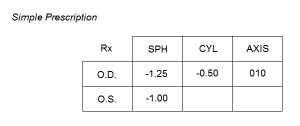By: Anthony Tangeman
Parents concerned about their child’s eyesight often want to have a better understanding of their child’s eyeglasses prescription.. By learning how to read a prescription, parents can better understand their child’s vision. Understanding a prescription comes down to learning the layout of a prescription and the meaning of each number and character.
Whether a baby, child, or adult, a person’s prescription will have the same general format.
Prescriptions have two rows labeled O.D. and O.S. These are abbreviations for Latin terms that mean right eye and left eye respectively.
From left to right on the top row of the prescription you will always find SPH, CYL, and AXIS. It is important to note that there may not be a value entered for these categories, meaning there is no correction needed.
SPH stands for spherical power and describes the degree of nearsightedness or farsightedness. A positive value, or one with a plus-sign, means that your child is farsighted, while a negative value means they are nearsighted. CYL is short for cylinder power, while AXIS simply means axis. Both of these terms describe astigmatism, which is a scary-sounding word for a very common condition. It simply means that the front of the eye has less of a perfectly round shape. The Cylinder value shows the severity of astigmatism, while axis measures the orientation of astigmatism.
To learn more about astigmatism, be on the lookout for our next blog post.
Depending on where the prescription came from there may be additional elements to your child’s prescription.
To the right of AXIS you may find ADD, PRISM, and P.D. ADD stands for addition and is used with multifocal lenses. ADD is additional magnification which helps with vision at close range. PRISM is used to help people with muscular imbalance in their eyes. P.D., or pupillary distance, is the distance between the centers of the pupils, which is used to position the lenses in frames.
If you would like more information on measuring P.D., please view our blog post on it.
While intimidating at first, eyeglasses prescriptions can be understood as long as you learn the layout and the meaning of the characters and numbers. If you have any questions regarding your child’s prescription, or anything else related to prescription lenses and frames, please contact customer service at GoSmartEyewear.

